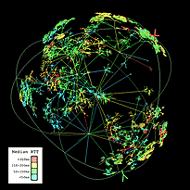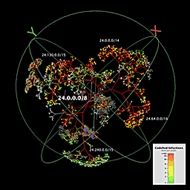

 Skip to navigation
Skip to navigation
Site Primary Navigation:
- About SDSC
- Services
- Support
- Research & Development
- Education & Training
- News & Events
Search The Site:

Published 06/14/2005

Walrus visualization of round-trip time measurements made by a CAIDA large-scale Internet topology monitor located in Herndon, Virginia. |
Developed by CAIDA researcher Young Hyun, Walrus can provide researchers with useful visualizations of tree-like hierarchical graphs that have hundreds of thousands of nodes. Because few software tools are capable of visualizing graphs of this size, Walrus is proving valuable to researchers with large data sets, and in a variety of areas. In addition to using Walrus in Internet research and visualizing phylogenetic trees, there is interest in using it in studying topics such as the interdependencies of the modules making up large software and the structure of social networks.

Walrus visualization of the number of hosts infected by the CodeRed worm in a 24 hour period, aggregated within Internet prefixes. |
In an open source effort, users collaborate in developing, maintaining, and peer-reviewing a common software tool. The source code is made available to the public, and the user community cooperates on its development, identifying and fixing bugs and adding new features that benefit the whole community.
Walrus is being released under the GNU General Public License (GPL). In conjunction with Walrus, CAIDA is also releasing LibSea, a file format and Java library for representing large directed graphs. LibSea is being released under the GNU Lesser General Public License (LGPL), which also allows commercial software to use this library.
CAIDA promotes the engineering and maintenance of a robust and scalable Internet infrastructure by providing tools and analyses to the planners and service providers who keep the Internet going. CAIDA's large scale topology monitoring of the global Internet, from approximately two dozen active monitors around the globe to almost a million Internet Protocol destination addresses, is the largest Internet topology mapping project in the world.
CAIDA and Walrus are supported by the National Science Foundation, the Defense Advanced Research Projects Agency, and commercial sponsors.